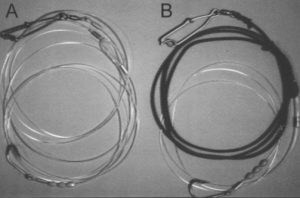Nylon Leader
WHAT IS A NYLON LEADER?
In commercial longline fishing, a “leader” is a length of filament that connects the main line and the lure to provide extra protection for gear when fishing. Traditionally, leaders have been made from wire due to its robustness. However, this means that sharks are less able to bite through the leader if accidentally hooked, increasing the risk of their bycatch. As a result, wire leaders have been banned in some fisheries.
Research indicates that leaders made from nylon (also known as monofilament) better enable sharks to sever the line and escape after being hooked, and can also increase catches of target species due to the lower visibility of nylon in water in comparison to wire.

Examples of nylon leaders, with (A) untarred and (B) tarred (tarred nylon has not been included in the majority of trials). Source: Stone & Dixon 2001
CURRENT RESEARCH AND USE
Since the 1980s, nylon leaders have seen increasing use and trials in tuna and billfish longline fisheries in the Atlantic, Indian, and Pacific oceans. In a trial with a swordfish fishery in the Indian Ocean comparing bycatch rates of wire and nylon leaders, longlines with wire leaders caught more blue sharks and the mean size of the bycaught sharks was greater. This suggests that switching to nylon leaders could not only reduce shark mortality overall, but also reduce the mortality of individuals more likely to be of breeding age. Target catch rates in the fishery, meanwhile, were unaffected by nylon leaders. Similar results were found in Southwest Atlantic swordfish and tuna longline fisheries, where 97% of shark “bite off” events occurred on nylon leaders – whereas the nylon leaders caught more target bigeye tuna. A more recent study in the Atlantic also found that nylon leaders reduce shark bycatch and increase target catch rates.
The drawback of sharks being better able to sever nylon leaders is that this increases rates of gear loss, as noted by researchers conducting a trial in an Australian fishery. However, financial costs were outweighed by the increase in target catches, with fishes such as tuna less able to see nylon in the water and therefore less able to avoid hooks.
Debate remains around the survival of some sharks after bite-off events, especially in cases where the hook has been swallowed. Researchers have called for further research to improve understanding of how different components in longline gear interact to affect bycatch rates and morality of bycaught animals, for example the use of circle hooks or j-hooks in combination with wire or nylon leaders (find out more about circle hooks on the Hub here).
Interested in how this and other measures could mitigate bycatch in your fishery? Get in touch with us to collaborate or take part in a study.
This page was last updated on 10.12.24.
